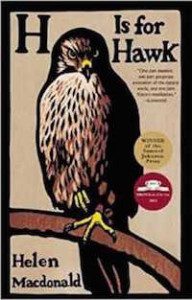
I recently wrote a blog post saying that I’d grown weary of reading memoirs about dying-dead-or-dysfunctional parents and wish these tomes would just fade away. To afford that luxury, I’d have to kill off millions of readers who are hungry for tales of sadness, bottoming out and ultimate redemption. From my point of view, most contemporary memoirs are the reality TV of modern literature. Memoirs are supposed to be true; they should not be fueled by the writer’s invention. So whenever I find Proustian recall in a memoir, I suspect that the book is larded with imagined details and events.
The lovely, beguiling H is for Hawk is a notable exception to the genre. In addition to participating in the profound grief that the writer feels for her deceased father, we learn about the age-old profession of falconry. This is a fascinating pastime, with its own lexicon of evocative terms such as “bating”: when a hawk or falcon nervously or aggressively flaps its wings. Quite unselfconsciously, as the author writes about acquiring and training a goshawk, she evolves into fascinating and compelling narrator.
Despite the fact that this book has become a best seller in the UK, Macdonald has continued to work as a research scholar of history at Cambridge. Academics tend to write in a clotted, complex style better suited to highbrow journals. Macdonald, however, is a remarkably gritty writer with a keen awareness of the psychological conundrums that bedevil us more common folk. About the stages of mourning, she writes, “The archaeology of grief is not ordered. It is more like earth under spade, turning up things you had forgotten. Surprising things come to light: not simply memories, but states of mind, emotions, older ways of seeing the world.” I read a lot of this book on Kindle and was not surprised to see many passages underlined by other appreciative readers. So much of H is for Hawk is eminently quotable.

Mabel, the goshawk, is “bulkier, bloodier, deadlier, scarier” than the garden-variety hawk. Macdonald teaches the bird to land on her wrist and mind her commands, and she monitors the hawk’s pursuit of hares and pheasants. The two go hunting together. The author trails her wild alter ego and like a God of mercy feels compelled to twist the necks of the quarry that Mabel has attacked but not yet murdered. “Hunting makes you animal, but the death of an animal makes you human,” Macdonald writes. The fresh look at dying creatures harkens back to the death of the author’s father and adds a deeper layer of artistry to the book itself. “I’d fled to become a hawk, but in my misery all I had done was turn the hawk into a mirror of me.” And also, “When people are separated from their demons they feel pain. This was a universe very close to mine. I felt incomplete unless the hawk was sitting on my hand: we were parts of each other. Grief and the hawk had conspired to this strangeness. I trusted she would fly to me as simply and completely as I trusted gravity would make things fall.”
The other unique component of H is for Hawk is the author’s preoccupation with the English writer T.H. White, who wrote a book called The Goshawk, a chronicle of his doomed attempt to train a predatory bird. Macdonald became fascinated with White when she was a child dreaming about becoming a falconer herself. The present-day narrative of Hawk is framed against her painstaking portrait of White’s life in the early part of the 20th century. She devotes many passages to his difficult struggle to train his hawk, his struggles with homosexuality and alcoholism and loneliness. I must confess that while these chapters were finely integrated into Macdonald’s account of her own day-to-day battles with grief, depression and hawk-training, I found myself resisting yet another portrayal of a gay man as unhappy, lonely and alcoholic. Americans (for better or for worse) are intrinsically less compassionate and tolerant of people with drinking problems—unlike the British, we tend to see it as a character flaw.
The compelling nucleus of H is for Hawk is made up of Macdonald’s often-inconsolable sadness, the portrait of anger over losing her father; the difficulty—and sometimes futility—of being an academic; and most of all the daunting challenge of raising and training a goshawk. When the author describes the natural landscape with precision of a great nature writer, the book positively soars. Imagining the hawk’s perspective, Macdonald writes “Her world was an aviary no larger than a living room. Then it was a box. But now it’s this; and she can see everything: the point-source glitter on the waves, a diving cormorant a hundred yards out; pigment flakes under wax on the lines of parked cars; far hills and the heather on them and miles and miles of sky where the sun spreads on dust and water and illegible things moving in it that are white scraps of gulls.”
Ultimately, H is for Hawk does become a tale of healing and redemption, and this probably accounts for its immense popularity. Yet it remains a singular and completely original document on grieving. In the final pages, finding a card written to her by her departed father, Macdonald concludes, “And now, holding the card in my hands and feeling its edges, all the grief had turned into something different. It was simply love.”




